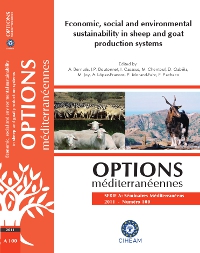| Article précédent | p. 211-216 | Article suivant |
Characterization of Segureña sheep production systems in the area of Sierra deI Segura y la Sagra, Spain
The aim of this study is to present the basic characteristics which define the sheep systems in some zones of the PGI Cordero de Segura y la Sagra protected area, in order to bring about actions to improve the competitiveness of such systems. A survey has been conducted among 93 farm owners. The questionnaire included questions regarding herd characteristics, age, educational level, workers, and continuity of the farm activity. The average herd size is 378 animals and the Segureña breed sheep is predominant (99 percent). In 93.5 percent of cases the owner works full time on the farm and the main economic benefit is the sale of lambs for meat, but only 9.7 percent of farmers belong to some kind of marketing cooperative. The average farmer's age is 50 years old and a high percentage (87.1 percent) has no education or a very basic one. The year work unit (YWU) is 1.31 and the work is mainly of family type. In only 12 percent of the cases the continuity of the activity is assured. The above analysed aspects show that it is necessary to achieve better socioeconomic conditions of farms. The PGI Cordero de Segura y la Sagra could be useful to improve these aspects. Therefore we suggest that the PGI must be promoted among farmers, especially among young people.
Le présent article se propose d'analyser les principales caractéristiques du secteur ovin dans une partie de la zone géographique sous Indication Géographique Protégée (IGP) Cordero de Segura y la Sagra. Une enquête a été menée auprès de 93 propriétaires d'élevages, dans l'objectif de connaître la situation du secteur dans cette zone. Les questions concernaient les sujets suivants: caractéristiques du troupeau, âge, niveau d'études, ouvriers à la ferme, continuité des activités de la ferme. La taille moyenne du troupeau est de 378 animaux et la race Segureña est prédominante (99 pour cent). Dans 93,4 pour cent des cas l'éleveur travaille à temps plein dans l'exploitation et le revenu principal est la vente d'agneaux pour la viande, mais seulement 9,7 pour cent des éleveurs font partie d'une coopérative pour la commercialisation. L'âge moyen du fermier est de 50 ans et 87,1 pour cent des éleveurs n'ont pas fait d'études ou de faible niveau. La moyenne du travail employé est de 1,31 UTA, essentiellement de type familial. Dans seulement 12 pour cent des cas, il existe une sécurité de la continuité de l'activité. Les résultats obtenus montrent qu'il est nécessaire de parvenir à de meilleures conditions socioéconomiques pour les exploitations dans la zone étudiée. L'IGP Cordero de Segura y la Sagra pourrait être utile pour améliorer ces aspects.
- [ Afficher ]
- [ Télécharger ]
- [ Exporter la citation ]
Vous pouvez télécharger la citation au format :
- [ Imprimer ]
-
Mots-clés
AGNEAU, APPELLATION D'ORIGINE, ESPAGNE, INDICATEUR ECONOMIQUE, OVIN, SYSTEME D'ELEVAGE, SYSTEME D'EXPLOITATION AGRICOLECiter cet article
Navarro-Ríos M.J., Marín-Bernal A.M., Martí A., Fernández C. Characterization of Segureña sheep production systems in the area of Sierra deI Segura y la Sagra, Spain. In : Bernués A. (ed.), Boutonnet J.P. (ed.), Casasús I. (ed.), Chentouf M. (ed.), Gabiña D. (ed.), Joy M. (ed.), López-Francos A. (ed.), Morand-Fehr P. (ed.), Pacheco F. (ed.). Economic, social and environmental sustainability in sheep and goat production systems. Zaragoza : CIHEAM / FAO / CITA-DGA, 2011. p. 211-216. (Options Méditerranéennes : Série A. Séminaires Méditerranéens; n. 100). 7. Proceedings of the International Seminar of the Sub-Network on Production Systems of the FAO-CIHEAM Inter-Regional Cooperative Research and Development Network on Sheep and Goats, 2010/11/10-12, Zaragoza (Spain). http://om.ciheam.org/om/pdf/a100/00801507.pdf



